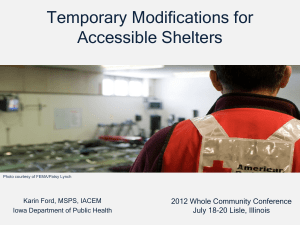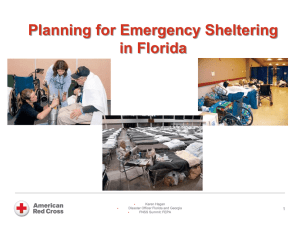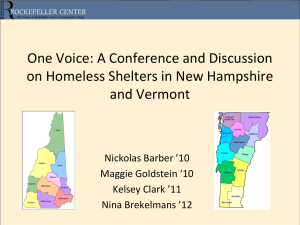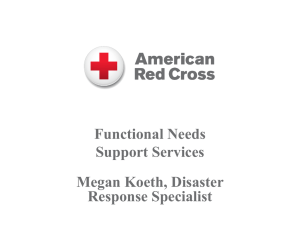AFN Mass Care Shelter
advertisement
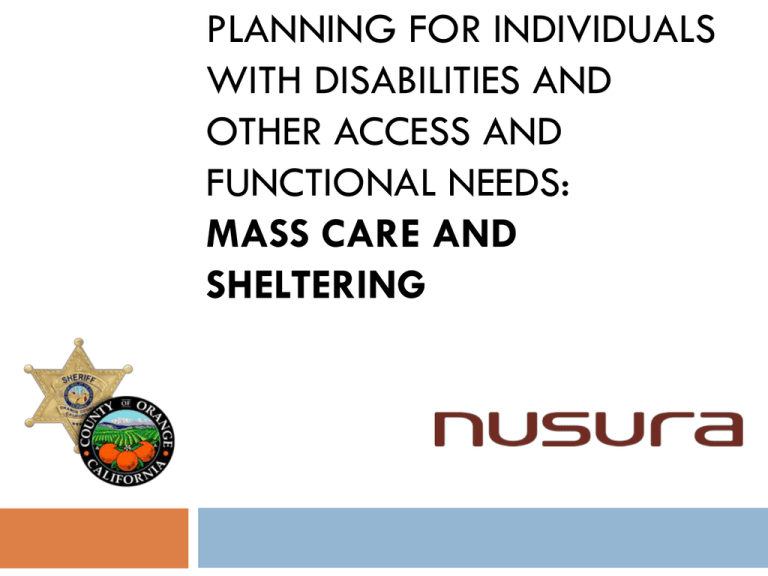
PLANNING FOR INDIVIDUALS WITH DISABILITIES AND OTHER ACCESS AND FUNCTIONAL NEEDS: MASS CARE AND SHELTERING This presentation was created by Nusura, Inc. for the Orange County Sheriff’s Division of Emergency Management Facilitator Introductions June Kailes Gary Gleason Participant Introductions Name Title Agency/organization Role during an emergency Logistics Safety Electronics Breaks Contact Info Survey feedback Agenda Key considerations and guiding principles Shelter and mass care planning Shelter operations Transition and recovery Key Considerations The needs of those with disabilities and other AFN CANNOT wait to be identified and addressed once an emergency or disaster occurs. Guiding Principles Under the Americans with Disabilities Act (ADA), children and adults with disabilities are entitled to equal opportunity to participate in programs, services, and activities in the most integrated setting. Guiding Principles ADA mandates equal opportunity to Programs Services Activities Shelters must be architecturally AND programmatically accessible Guiding Principles The primary goal of sheltering and mass care is to help people stay safe, healthy, and independent. What is a Mass Care Facility? Facilities include pre-identified: Shelters Non-traditional shelters Medical shelters Evacuation centers Disaster assistance and resource centers Mass feeding sites Point of Distribution Sites (PODS) Safe refuge sites Resettlement processing centers Decontamination sites Shelter Types Mass Care Serve the general population Medical Provide a heightened level of medical care for people who are medically fragile House people who require the medical care that would usually be provided by medical professionals in a nursing home or hospital Who Shelters Where Shelter people with disabilities and other access and functional needs in mass care shelters. Most people with disabilities and other access and functional needs are not medically fragile ADA requires accommodation in most integrated setting possible Who Shelters Where How’s people in mass care shelters even if they’re not accompanied by their personal care aide In most instances, people who normally get help with activities of daily living (eating, dressing, routine health care, personal hygiene, etc.) can be housed in a mass care shelter Local governments and shelter operators may not make eligibility for mass care shelters dependent on a person’s ability to bring his or her own personal care attendant Consider using trained volunteers to help with these tasks Identifying Shelter & Mass Care Sites Federal and State laws require that children and adults with disabilities have equal opportunity to access emergency programs and services. Without modifications, some shelters are not appropriate to support the integration of those with AFN. With a few modifications and minimal expense, some spaces can easily be made accessible. Evaluating a Shelter Site Shelters need accessible: Entrances Routes to all services/activity areas Routes within toilet rooms Passenger drop off and pick up areas Parking Sidewalks and walkways Shelter entrances, hallways, and corridors Check in/information areas Evaluating a Shelter Site, continued Sleeping areas Restrooms, showers, and toilet stalls, including portable toilets Public telephones Drinking fountains Eating areas Medical first aid areas Recreation areas Selecting a Shelter Site State codes and standards must, at a minimum, meet the Federal requirements, but can be more comprehensive. The ADA and other Federal laws, including the Stafford Act, the Rehabilitation Act, the Fair Housing Act, and the Architectural Barriers Act, provide affirmative obligations and prohibitions of discrimination on the basis of disability. No State or local government, or its contractors, may, by law, policy, or contract, provide services below those standards without violating Federal law. Equipping and Supplying a Shelter Shelter and Mass Care sites should be prepared to provide or connect people to durable medical equipment, medication, and other resources to help people stay safe. Support Services The following are examples of types of services that should be available in a general population shelter: Power generation Health service providers Communications providers Food service providers Transportation providers Durable medical equipment Consumable medical supplies Staffing the Shelter Emergency managers and shelter planners should integrate people with expertise regarding access and functional support needs into the staffing plan. Agencies in the stakeholder group are often a good resource for providing shelter staff with appropriate experience. Assessment Teams FAST Other assessment resources Shelter Intake An individual request for an accommodation, based on disability or other AFN, should be provided even if not requested during the initial intake. Dietary Considerations Plans should also include a process for responding quickly to unanticipated dietary needs and restrictions. Food preparation techniques may need to be adjusted (e.g., food may need to be pureed) to meet resident needs. Considerations for Service Animals Under the ADA, a service animal is one animal that is individually trained to provide assistance to a person with a disability. Must be allowed in and provided appropriate accommodation. Animals may help with a non-visible disability. Considerations for Service Animals, continued If an animal is not immediately identifiable as a service animal, shelter staff may ask only two questions to determine if an animal is a service animal: 1. “Is this a service animal required because of a disability?” 2. “What work or tasks has the animal been trained to perform?” Communication Considerations The ADA states that “a public entity shall take appropriate steps to ensure that communication with applicants, participants, and members of the public with disabilities are as effective as communication with others.” This applies to sheltering and mass care services. Assistive Technology Assistive technology can help people with disabilities and access and functional needs communicate iPads –apps can provide enlarged text , picture, immediate access to interpreters and translation Magnifying Readers – Enlarges text for people with low vision Enhanced Listening Devices – improves the clarity of sound Live Video Interpreting – provides immediate access to sign language interpreters standing by at a remote location Captioned Phones – provide real-time voice-to-text for people who can speak on the phone but cannot hear the caller on the other end Quiet Area The stress that is created during and after an emergency or disaster is increased as a result of the noise and crowded conditions of a shelter. Plans should include a strategy for providing a quiet area within each general population shelter. Quiet areas must be accessible. Other support services Mental Health Care Medical Care Recovery services Victims advocacy (if event was crime related) Transit and transportation Day care Key Considerations For Transition and Recovery Transitioning Back to the Community In order for children and adults who have access or functional needs to transition back to their community, it is important to provide them a reasonable amount of time and assistance to locate suitable housing when they cannot return to their former homes. Questions? Discussion Questions Are there any situations where it is legal and appropriate to set up a separate AFN shelter? Some OC city plans call for them. Is there a difference between an official or sanctioned shelter site and an improvisational site? How does the law apply? Discussion Questions OC is linguistically diverse. What are strategies for communicating when translators may not be available? How will people know about shelter sites in major events when power and traditional media are down? Share your thoughts! Thank You! Please complete the course feedback form before you leave




